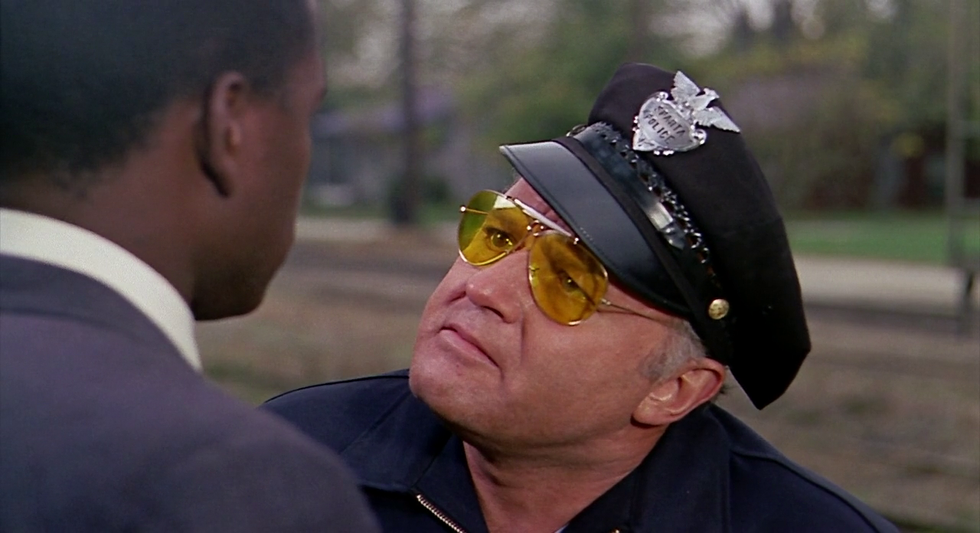You must watch these five movies
In the Heat of the Night (1967)
Seeing this movie for the first time in New York's Quad Cinema, it didn't feel like I was watching a movie that had been made 50 years ago. But maybe because as I was watching the film, thoughts of the Black Lives Matter movement lingered in the back of my head. And as I watched Virgil Tibbs (played by Sidney Poitier), a black homicide detective from Philadelphia waiting to be picked up at a Mississippi train station, I feared for his life as he is approached and apprehended by a sheriff, who brings the detective to be questioned in connection with a recent murder by the local Police Chief, Bill Gillespie (played by Rod Steiger.)
But what makes this movie relevant today is not just that a white Police Chief is forced to acknowledge and shift his racial biases (only after learning that Tibbs is actually an expert in forensics could help him with a murder case.) As journalist Alyssa Rosenberg puts it, Gillespie also learns to adjust his "moral mathematics", or how calculates who is worthy of basic respect.
I like to believe that by the film's end, his experience working with Tibbs pushes him in a direction in which he feels ideologically isolated from the rest of his racially-charged community. And perhaps this is something we could learn from to approach the racial struggles in our country today.
Bonnie and Clyde (1967)
Like "In the Heat of the Night", "Bonnie and Clyde" also doesn't feel like it was made 50 years ago—but I'd attribute this to how accustomed I've become to seeing action sequences in modern-day movies. But what's incredible about this film, which at the time became notorious for its depictions of graphic violence, is that it doesn't use violence for "shock value" or action sequences as "wow factors", but instead uses both to drive this story.
Roger Ebert explains this point further, describing the emotion that was injected into these types of sequences. After Bonnie and Clyde (and company) are ambushed the first time, you don't just see C.W., the accomplice, speeding off to bring the badly injured criminals to safety, but seeing Bonnie and Clyde (played by Faye Dunaway and Warren Beatty) in such pain has the strange effect of imparting feelings of sympathy onto the viewer. The opposite effect is also achieved in the scenes in which Bonnie and Clyde triumph in a number of their bank heists; as they speed off from the scene feeling excited and proud, you may find yourself manipulated into experiencing these feelings of elation, and then rooting for these antiheroes during their pursuits.
You may have an idea of how Bonnie and Clyde's story ends, but the movie's final scene will leave you SHOOK...just temporarily, though. It's the cinematic storytelling of "Bonnie and Clyde" that will resonate with you, and may even make you shift how you view what makes a film "great" going forward.
Rear Window
In our age of social media, such platforms aim to connect us with people in an online space, but instead often making us feel isolated instead. We instead find ourselves with getting glimpses of peoples' lives through Facebook, Instagram, and Snapchat without establishing a personal connection with the people behind the profile—or even engaging with them at all.
But replace social media with a window and a pair of binoculars for people watching, and you'll find that the same concepts are at play in "Rear Window". On its own, Alfred Hitchcock's classic is a suspenseful thriller that will captivate you from start-to-finish, but also makes commentary on a culture of voyeurs, or "Peeping Toms," as Stella (played by Thelma Ritter) says in the movie, that existed then—and certainly exists today.
The movie involves many sequences in which L.B. Jeffries (played by Jimmy Stewart) uses his binoculars to get a look into his neighbors' open windows from across his apartment complex. Through this act of "watching", he gains superficial views into his neighbors' lives and makes snap judgments about them based on his observations. (Sound familiar?) But he also views the life in front of him the same way. Until the end of the movie, Jeffries talks about his girlfriend Lisa (played by Grace Kelly) based on what she presents on the surface while failing to (and sometimes avoiding) to develop a deeper connection with her. He puts her on a pedestal while wishing for her to be "ordinary", but by the end of the movie, we join Jeffries in discovering that this view of her is out-of-sync with who she really is—and what she had the potential to do all along.
In our modern culture in which this type of voyeurism is strong in our digital lives, we need more than ever to put down the binoculars and discover life around us as it actually is.
Adam's Rib (1949)
I love old screwball comedies! Not just because they evened the playing fields for male and female characters, but also because these films allowed for protofeminist ideas to shine through. This is very true in many of the screwball comedies starring Katharine Hepburn, and this is especially true in "Adam's Rib" (one of many screwball comedies she starred in alongside the love of her life, Spencer Tracy.)
In "Adam's Rib", Katharine Hepburn plays Amanda Bonner, an accomplished lawyer (this alone makes her character AWESOME), who is drawn to defend a woman charged with attempted murder on her cheating husband—which means working against her own husband, Adam Bonner (played by Spencer Tracy) who stubbornly believes the defendant was in the wrong.
But it isn't sympathy that compels Amanda to take the case, but her desire to show society's biases regarding the double standards of male and female behavior—and how troubling those biases are. And by the film's end, she even challenges her own husband's chauvinistic biases for the better.
Show People
Between the Kardashians, reality television, and 90 years of "self-celebrating" at the Academy Awards ingrained in our culture, a film like "Show People" that gave an inside look into the glossy phoniness of Hollywood present to the public during the silent era still feels so relevant in today's age of entertainment.
While Chaplin's silent films are revered today for beautifully tackling social issues with brilliant comedy, this more obscure silent gem presents hilarious commentary on celebrity-worshipping and the molding of celebrity personas. And with its fast-paced humor, not one minute of "Show People" felt boring or slow—and even made me forget I was watching a silent movie.






















